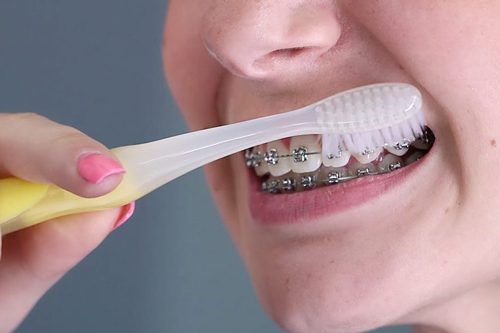When you have braces on teeth, those teeth need extra attention to protect them from decay, staining and gum disease. You should also take precautions to avoid damaging the braces. For example, activities to avoid include eating chewy or sticky sweets, eating hard or crunchy foods, biting your lip, breathing excessively through your mouth and pushing your tongue against your teeth.
Brushing
Although brushing twice a day is the standard oral care recommendation, when you wear braces, you should brush after every time you eat — even after that mid-afternoon vending machine snack or some late-night munchies. That’s because food particles easily become trapped in the braces, and the longer those particles stay trapped, the greater risk you have of developing dental problems. Use a soft toothbrush , or an electric toothbrush if you prefer.
Start by rinsing your mouth with water to loosen food stuck in and around your braces. It’s important to brush each tooth at the gum line and both above and below the brackets. Brush your gum line first, holding the toothbrush at a 45-degree angle. Next, clean the brackets by brushing at a downward angle on top of the brackets and brushing at an upward angle at the bottom of the brackets. Rinse again after brushing.
Other Cleaning Methods
Floss at least once a day, making sure you floss not only between the braces but also under the wires. To more easily floss under the wires, use a floss threader or orthodontic flosser, which you can buy at drug stores. Waxed floss is easier to slide between your teeth and less likely to snag on your braces than unwaxed floss.
If you have space between your teeth, you might find that an interproximal (also called interdental) brush that goes between the teeth works better than flossing. Another option for hard-to-reach areas is an oral irrigator. Its stream of pulsating water can remove plaque and food debris.
Watch What You Eat
When you wear braces, you need to be more aware of what you eat. Eating too many sugary and starchy foods can cause plaque to build up around the brackets, which can cause staining of the teeth, causing cavities or leading to gum disease. You should especially avoid sticky and chewy foods, such as dried fruits, caramel, taffy, corn on the cob and chewing gum, all of which can become stuck and be hard to remove from braces.
Hard foods are another no-no. Foods such as nuts, ice, popcorn and beef jerky can break the wires of the braces and loosen the brackets. Even otherwise healthy foods, such as raw apples and carrots, can be problematic because their hard texture can damage the wires. To eat crunchy foods, cut them into small, bite-size pieces.
Invisalign
Invisalign offers a number of benefits over traditional orthodontics. Patients love that they are unnoticeable, comfortable and removable. Unlike metal braces, Invisalign wearers are not presented with extra challenges when brushing and flossing. This is a remarkable advantage towards the health of your smile during orthodontic treatment. However, it doesn’t mean that you get a free pass to neglect the health of your teeth and gums all together.
Although Invisalign trays can be removed for brushing, there are still some things to watch out for. The most significant step you can take towards a healthier smile while wearing Invisalign is to taking diligent care of your aligner trays as well as your teeth.
West Paces Ferry Orthodontics patients usually wear trays for a week each. That may not seem like a long time, but it is plenty of time for bacteria to harbor inside your trays, especially if your tray gets scratched. Your trays can also seal food particles into your teeth that you may have missed with brushing and flossing. This creates a welcoming environment for tooth decay and even gum disease.
During Invisalign therapy, you can expect to wear your trays about 22 hours per day. Therefore, follow these care tips to ensure your smile stays healthy while it gets straighter:
- Use a soft-bristle toothbrush to daily clean your trays
- Store your trays in their case when they’re not in your mouth
- Always brush, floss, and rinse your teeth immediately before putting trays back in
- Don’t let trays get dry for long periods of time
- Avoid smoking while undergoing Invisalign treatment
Additional Tips
If you are caught without a toothbrush, vigorously rinse your mouth with water (or mouthwash) and brush as soon as possible. Also, if your braces or wires chafe the inside of your lips, you can place a special wax on them to prevent this from happening and rinse often with salt-water. You can get this wax at drug stores, or just ask your dentist or orthodontist.









